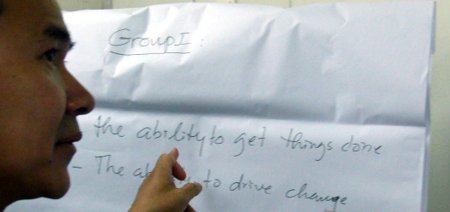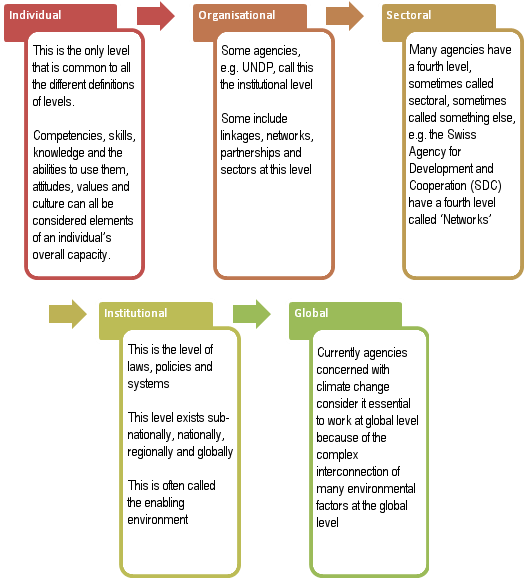Levels

Any comprehensive analysis embraces the fact that capacity exists at multiple levels. One of the most frequently used specification of levels is: Individual – Organisational – Institutional. However there are many variations on this theme, both in terms of what the levels are called, and how many there are.
The illustration below shows that it is not possible to offer clear cut definitions about levels, and it would not be wise to try to do so. Each agency needs to define the levels that are appropriate for their particular mandate and context. The really important point to stress is that, if capacity development initiatives are to have any chance of achieving sustainable results, capacity needs to be considered not just at one level, but in terms of the linkages between levels and the complexity of the whole system.

An example of using the levels to create a framework for action comes from Rwanda, where the Public Sector Capacity Building Secretariat has identified the need for capacity creation, utilization and retention and applied these at individual, organisational and institutional/policy levels to develop a matrix which guides the work on capacity development, as shown below:
| Capacity creation | Capacity utilization | Capacity retention | |
| Individual level | Development of adequate skills, knowledge, competencies and attitudes | Application of skills, knowledge, competencies on the workplace | Reduction of staff turnover, facilitation of skills and knowledge transfer within institutions |
| Organisational level | Establishment of efficient structures, processes and procedures | Integration of structures, processes and procedures in the daily workflows | Regular adaptation of structures, processes and procedures |
| Institutional and policy environment level | Establishment of adequate institutions, laws and regulations | Enforcement of laws and regulations for good governance | Regular adaptation of institutions, laws and regulations |
Types of capacity
As with other information given in this section about the core concept, the lists below of types of capacity are not intended to be definitive. These lists are simply a synthesis of current ideas drawn from many different sources. Different agencies differentiate types of capacity according to what fits best to their frameworks. It is advisable for anyone working on capacity development initiatives to spend some time to think about what types and differentiations of capacities fit best to their own needs.
As shown below, types of capacity are often distinguished under different headings such as ‘hard and soft’ ‘technical/functional’ and ‘social/relational’, or ‘visible and invisible’. The distinctions between some of these capacities are not always as clear cut as the boxes suggest, they are presented in this way to highlight the classification of the types. There is now a growing recognition that in many circumstances soft capacities are essential underpinning requisites for other types of capacity to exist.
Different types of capacity may be applied to individuals, groups, organizations, networks as well as to the systems and conditions in institutional enabling environments. According to the context different capacities are needed for different reasons, in different combinations and measures. Most usually capacity will be a mix of hard and soft components that fit to the context and enable individuals, organizations, networks and broader social systems to carry out their functions and achieve their development objectives. Support for the development of any capacity therefore needs to be approached in different ways. See the ‘How to’ pages for more information.
Types: examples of hard and soft capacities
| Hard | Soft |
Capacities that are generally considered to be technical, functional, tangible and visible
Note: tangible resources like infrastructure, money, buildings, equipment and documentation can be considered as the material expression or product of capacity, but they are not capacity in and of themselves. | Capacities that are generally considered to be social, relational, intangible and invisible Operational capacities such as:
|
Themes for application
At national, regional and global levels capacity development cuts across multiple themes and their related disciplines and communities, serving to connect the knowledge and experience that exists in each. Many agencies define themes for application of their capacity development work as a way to operationalise the overall guiding concept to local context and need or their own particular mandate. In some cases the themes define the areas in which capacity is needed, in others the themes are the drivers of change. Some examples of themes for application are given below, grouped to show some of the more obvious linkages. These themes can bring together many technical disciplines, schools of thought and communities of practice.
Examples of themes for application according to need are:
- Human capacity; human resource development; leadership
- Fragile states (this is also considered to be a context)
A national level framework was developed as part of the Ethiopian Civil Service Reform Programme launched in 1998. It was built around three areas of capacity need, specified as: human capacity; systems and procedures; and organisational structures and interrelationships
Examples of themes as drivers of change are:
- Democratic governance; accountability and transparency; citizen participation; ownership
- Institutional arrangements; systems and procedures; incentive structures; managing for capacity development results; organisational structures and interrelationships
- Knowledge and knowledge management
As with the other aspects of the core concept the way themes for application are used differs from one agency to another because they each work out what is best for their context. For example, where some agencies have accountability as a sub-component of democratic governance, the UNDP framework has accountability as one of its four ‘Core Issues’ (the other three are institutional arrangements, knowledge and leadership).
An example of using themes to structure a strategic approach to capacity development at a regional level is the NEPAD Capacity Development Strategic Framework, which specifies six cornerstones as the most critical success factors for capacity development in Africa as being:
- Leadership transformation
- Citizen transformation
- Knowledge and evidence based innovation
- Utilizing African potential, skills and resources
- Developing capacity of capacity developers
- Integrated planning and implementation for results.
Currently there are a range of different definitions of capacity and approaches to capacity development in use by different agencies, some of which are described on the following pages.
Next section: Capacity: what is it?